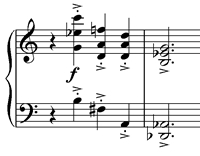General Principles of Harmony – Criteria for Evaluating Harmony
Following our discussion of general principles, we can now specify what poor harmony – in any style – sounds like. Inadequate harmonic sensitivity results in (unmotivated) inconsistency of harmonic worlds, and thus, testifies to unclear expressive intentions.
Typical cases include:
- Inappropriate or random accents. This variant of an example presented previously now has a cluster chord on the last beat of the first bar. This chord disrupts the voice leading and also is more intense than the other around it. It arrives in mid-phrase, at a moment which deserves no special accent.

- Inappropriate or random holes or dead spots. (The audible cases of parallel fifths and octaves usually fall into this category.) Another variant of of the above axample now has a bare, open chord on the last beat of the first bar. This chord sounds very empty compared to those around it. Again, its position in the phrase merits no special emphasis.

- Lack of direction, often along with a certain grayness, lack of meaningful contour. This variant of a previous example has here become aimless. The progression of interval tension now sounds haphazard: Intervals stay static for no reason and change at random places in the phrase. The climax is badly prepared, and the final cadence on the minor second is inappropriately harsh.

PEDAGOGY
Here are a few suggestions for teaching harmony:
- Usually the “rules” of harmony are presented as black and white: avoid parallel octaves, false relations, etc. This primitive guidance is only useful for a rank beginner. In practice, harmonic effects depend on context, and the real issue is that the composer must be very sensitive to harmonic consistency . For example, in Debussy’s La Cathédrale Engloutie,parallel fifths and octaves are part of a consistent sound world, and therefore do not stand out inappropriately. In teaching, a good approach is to “grade” harmonic situations on a scale according to aural prominence. Such a focus on gradations (scales of dissonance, accent, modulatory distance, etc.) develops the student’s ear for finer distinctions, and encourages more refined musical judgment, which is transferable to other situations, in a way that rigid rules are not.

In a normal four part polyphonic context, the parallel 5ths between outer voices are flagrant in “A”. However, in “B”, the parallel 5ths are much more subtle: They are in the inner parts, and the soprano distracts attention away from them through activity. In a homogeneous timbre, the (correct) voice leading in “C” is virtually indistinguishable from that in “B”.
- Sing and play: Harmony is ear training. The student should regularly sing individual parts while playing the others.
- Try alternatives: Often a fictitious recomposition of a harmonic passage with different voice leading or a different cadence will prove enlightening.
- Look for the leading part at any given time: Harmony is not a democracy. In most harmonic situations, certain notes contribute more to the overall effect than others. For example, cultivate the habit of searching for which intervals in a chord most influence its character.
- While it is useful to begin harmonic study with four part vocal textures – such a homogeneous texture is a good compromise between fullness and linear independence – exercises should eventually include writing for piano, as well as composing for various small ensembles, so as to explore the varied interactions between harmony and orchestration. Not all exercises should be in four parts.
